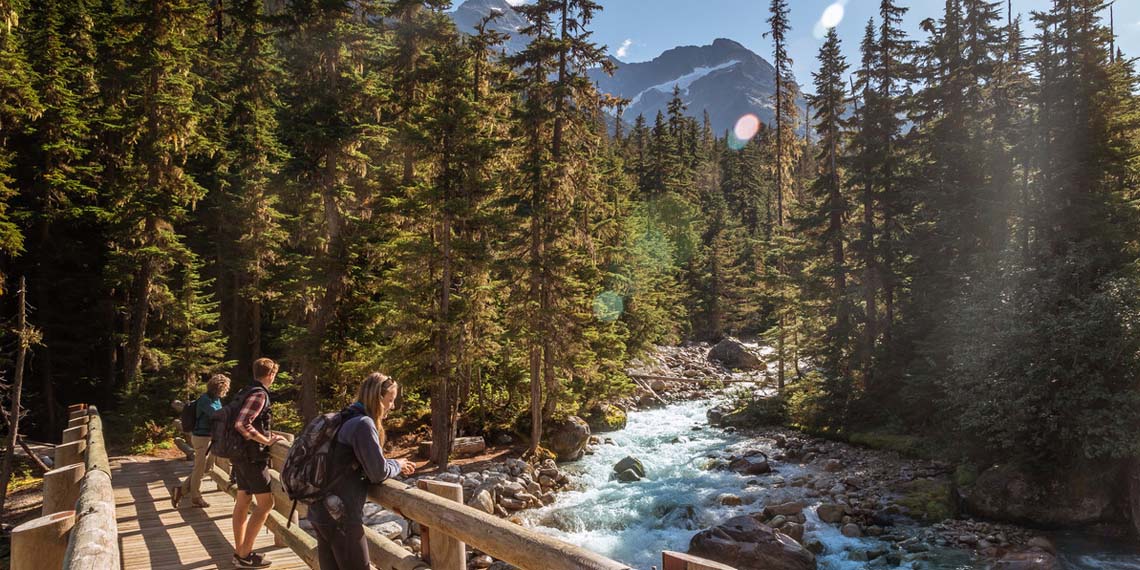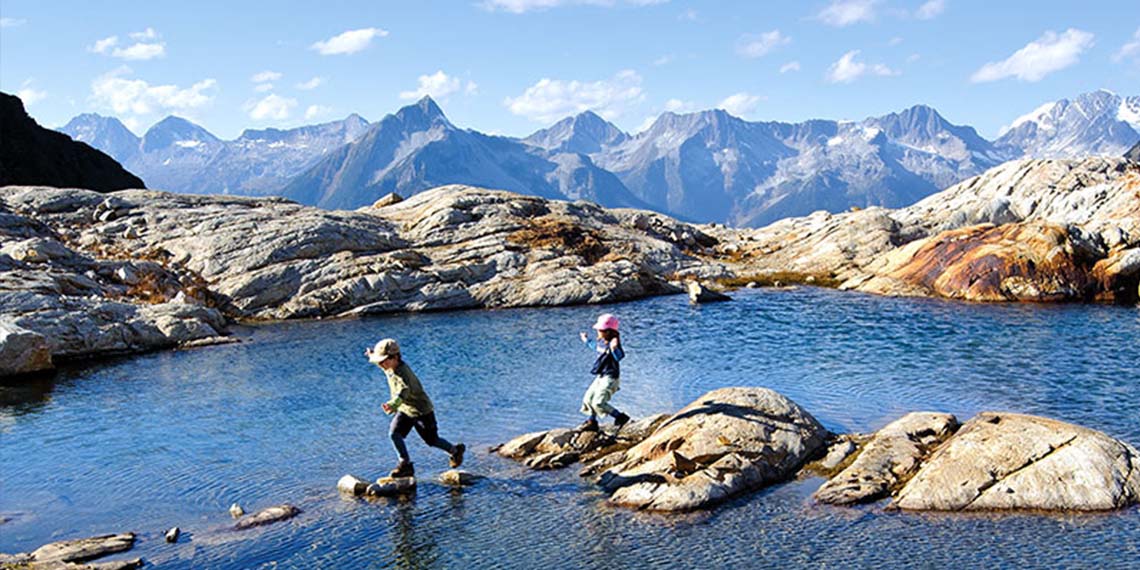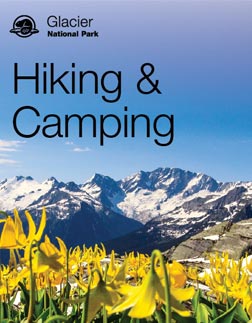
Perley Rock Trail
© Andrew Chad / Tourism Golden
Hiking
Glacier National Park
Hiking in Glacier National Park offers you the chance to explore the Columbia Mountains whether minutes from your car or hours from the nearest road. Trails range from short, valley-bottom strolls, to steep, tough climbs. Whatever trail you choose, come prepared for travel in a rugged mountain environment and unpredictable weather.
Most requested
Choose your trail
Prepare for your hike
-
Trail ratings
Select a trip that best suits your party’s abilities, experience, interests, and the time you have available. Estimated time to complete trails ranges depending on trail distances, fitness levels, weather and trail conditions.
Easy
- Suitable for those with little or no trail experience.
- Flat to gently rolling with few obstacles.
- Little or no elevation change.
Moderate
- Suitable for those with basic trail experience.
- Gently rolling with short, steep sections and infrequent obstacles.
- Moderate elevation change.
Difficult
- Suitable only for those with trail experience.
- Long, steep sections with frequent obstacles.
- Major elevation change.
When to go
Most trails in Glacier National Park are accessed off the Trans-Canada Highway. Some trailheads or day use areas may not be accessible until late June due to avalanche hazard and snow.
Spring (early May to late June): High elevation trails are snow-bound and may be subject to avalanche hazard. Trails are muddier at this time and the best hiking is at lower elevations.
Summer (early July to mid-September): Prime hiking season. Some snow may linger on higher elevation trails until mid-July. Subalpine wildflowers typically bloom in August.
Fall (mid-September to early October): Autumn in the mountains brings shorter days and cooler temperatures. Trail bridges are typically removed between late September
and early October for the winter.Rain or snow can fall any time of year in the mountains. Be prepared for unpredictable weather conditions and always check the forecast before embarking on your trip.Packing list
What should you bring? Use this handy checklist as a starting point for a safe and enjoyable day of backcountry hiking. Remember to leave a trip plan and pack spare items; it’s always best to be prepared for the unexpected!
- 🔲 Trail guide and map
- 🔲 Full water bottle or thermos
- 🔲 High energy food
- 🔲 Bear spray
- 🔲 Bug spray
- 🔲 Sunscreen and sunglasses
- 🔲 First aid kit
- 🔲 Headlamp or flashlight with spare batteries
- 🔲 Hat and gloves
- 🔲 Hiking poles
- 🔲 Rain/wind jacket
- 🔲 Extra warm clothing in case of an emergency
- 🔲 Cell phone or satellite communication device
Visiting with dogs
Dogs are not allowed on the Balu Pass Trail or anywhere within the Connaught Creek drainage.
Dogs cause stress for wildlife. Dogs may be seen as a threat, like a coyote or wolf, or as food. Off-leash dogs can trigger aggressive behaviour from wildlife such as grizzly bears. Please consider leaving your dog at home. To prevent unsafe situations, it is your responsibility to:
- Ensure your dog is always on a leash and under control.
- Pick up and dispose of your pet’s waste appropriately
Safety
Safety is your responsibility. There are always hazards associated with outdoor recreation. Even short trips may have serious consequences. Minimize your risk by planning ahead.
- Visit pc.gc.ca/glaciertrails for trail conditions and information, warnings, closures, and weather.
- Be prepared for emergencies and changes in weather. Mountain weather changes quickly and it can snow any month of the year.
- Travel with a friend or group. Choose a trail suitable for the least experienced member in your group.
- Pack adequate food, water, clothing, first aid kit, bear spray and map.
- Tell a reliable person where you are going, when you will be back, and who to call if you do not return.
- Ticks carrying Lyme disease may be present in the park. It is important to check yourself and your pet after hiking.
- Don’t use earbuds or headphones. Be alert at all times.
Snowy trails
Snow can remain on higher elevation trails well into the summer. When trails are snow covered, route finding can be difficult, and travel through deep snow or on hard snow and ice can be unsafe.
Avalanche risk
Steep, snow-covered slopes at any elevation have the potential to avalanche. Trails above the tree line (2,000 m) may be exposed to avalanche hazard at any time of the year and especially from November to June.
Trail etiquette
- To prevent damage to vegetation, stay on the trail.
- Show courtesy and yield to others.
- Use privies where available. Where facilities are not available, dispose of human waste at least 70 m from any water source. Bury solid human waste in a hole 15 cm deep. Pack out your toilet paper.
Wildlife and people
Glacier National Park is home to wildlife including wolves, cougars, grizzly bears and black bears. To successfully raise their young and sustain a healthy population, wildlife need access to as much quality habitat with as few human surprises as possible.
- Give wildlife space. Approaching wildlife causes them to lose their natural fear of people. Help keep them wild by maintaining a distance of 100m for larger species such as bears and 30m for species such as deer.
- Carry bear spray outside your pack. Ensure it is quickly accessible and know how to use it.
- Human food kills wildlife. Do not litter or feed wildlife.
- Make noise! Being quiet puts you at risk for sudden wildlife encounters. Be alert in shrubby areas and when approaching blind corners. Travel in tight groups and always be aware of your surroundings.
- Please report bear, cougar, wolverine and caribou sightings and encounters to Parks Canada when it is safe to do so. Email mrg.wildlife@pc.gc.ca
- A national park pass is required to visit Glacier National Park and Alpine Club of Canada facilities within the parks.
- Leave no trace. Pack out everything you pack in.
- Leave what you find—it is the law. Natural and cultural items such as mushrooms, wildflowers and rocks must remain undisturbed for others to discover and enjoy.
- Drones/UAVs are prohibited in all national parks as they disturb wildlife. Leave your drone at home or in your vehicle.
Regulations
Following park regulations while enjoying national parks helps protect people, landscapes, and wildlife.
Download map and trail information
- Date modified :


